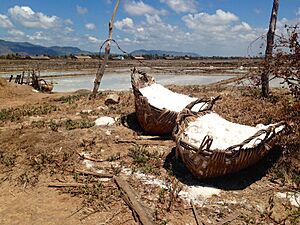Kampot sea salt facts for kids

Kampot sea salt is a special kind of salt made from seawater. It comes from the coastal areas of Kampot and Kep provinces in Cambodia. People make this salt using large, shallow pools called salt evaporation ponds. The sun and wind help the water evaporate, leaving the salt behind.
About 200 families own the salt farms in these provinces. These farms cover a huge area, almost 4,748 hectares (that's like 11,700 football fields!). They all work together as part of the Kampot-Kep Salt Association.
The very best Kampot sea salt is called Kampot Flower of Salt. It's also known as fleur de sel in French. This special salt is collected in small amounts. It's only harvested in April and May, which are the warmest and least windy months. This helps create the perfect conditions for this delicate salt to form.
Contents
The Story of Kampot Salt
Salt has been made in this region for a very long time. The salt industry grew a lot in the 1940s and 1950s.
During the time of the Khmer Rouge and the Cambodian Civil War, the government took control of all salt production. But in 1986, a group of people in Kampot were given land. They were allowed to start making salt again as their own businesses.
Salt Harvests Over the Years
The amount of salt harvested can change a lot each year. This often depends on the weather.
- In 2014, there was great weather for salt making. Farmers collected 147,000 tonnes of salt. This was almost double the amount from the year before!
- The dry season in 2015 was even longer. This allowed for a harvest of 170,000 tonnes. This helped Cambodia build up its salt reserves to 270,000 tonnes.
- However, in 2016, the harvest dropped to 140,000 tonnes.
In 2017, something exciting happened. A local company signed a deal to export Kampot sea salt to a French company. This was the first time Kampot sea salt was officially exported!
Important Changes for Health
In 2018, the Cambodian government made a big change. They wanted to help people get enough iodine. Iodine is important for health. So, from 2019, it became against the law to sell salt without iodine in Cambodia. Salt producers had actually been required to add iodine since 2003.
Facing Challenges: Weather and Climate
In recent years, salt producers have faced new problems. Changing weather patterns and rising sea levels are making it harder to produce salt. These changes are linked to global warming.
- In 2019, the salt harvest was very low, only 18,430 tonnes. This was a record low!
- Because of less income, some salt farmers started selling their land.
- Children of salt workers sometimes had to leave school to help their families.
To help with these issues, the Ministry of Industry, Science, Technology and Innovation of Cambodia created a special group in 2021. In 2022, they shared a plan for 2022–2026. This plan aims to help manage and protect the salt farms. It also wants to make salt production more efficient and help the farmers earn more.



